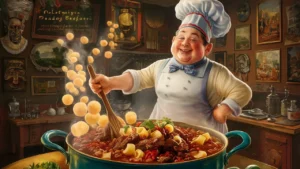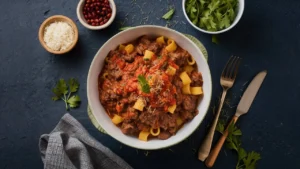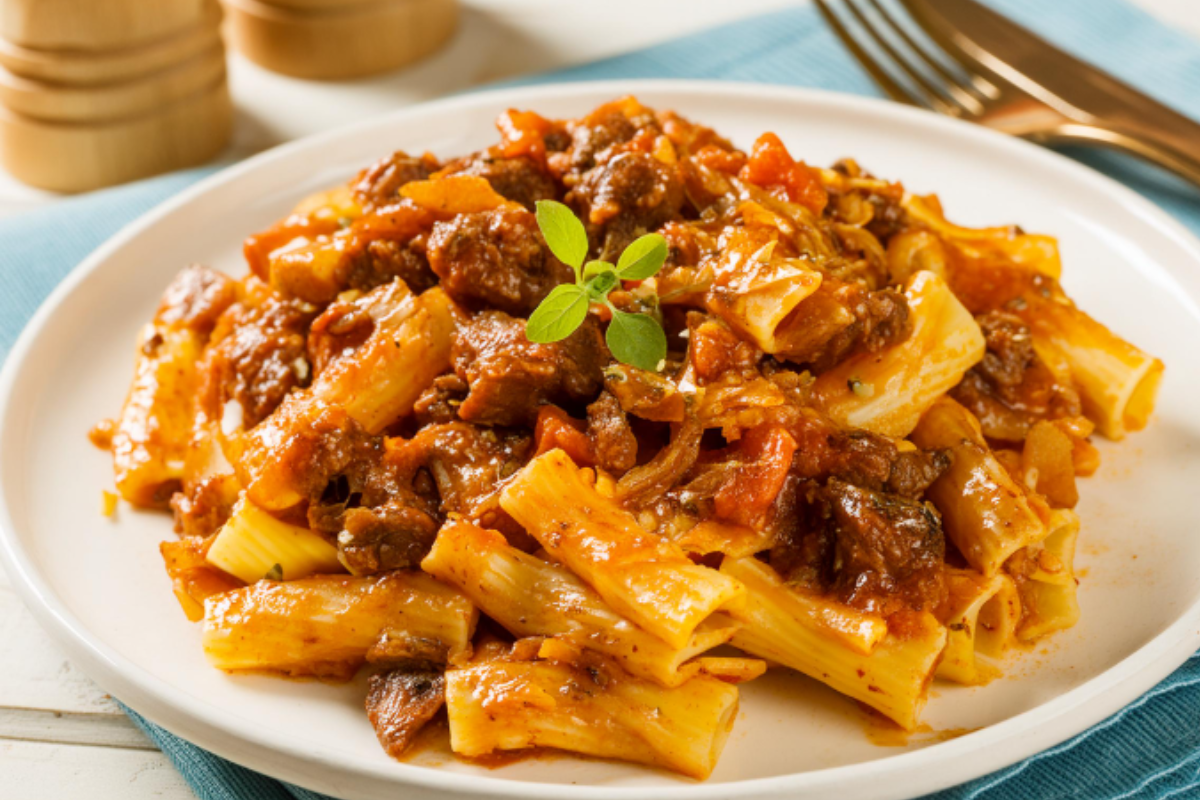Introduction to the Beefaroni Recipe Article
Beefaroni, that comforting blend of pasta, ground beef, and rich tomato sauce, often brings back delightful memories of family dinners and cozy evenings. This dish, beloved by many for its simplicity and heartiness, serves not just as a meal but as a warm hug on a plate. In this comprehensive guide, we’ll explore everything from the humble beginnings of beefaroni to the various ways you can customize it to suit your taste buds. Each section of this article is crafted to provide you with all the information you need to master this dish, enhance its flavor, and understand its nutritional content. So, whether you’re a seasoned chef or a culinary novice, get ready to dive into the world of beefaroni and bring a touch of comfort to your kitchen table.
Introduction to the Classic Beefaroni Dish
What Exactly is Beefaroni?
Ah, beefaroni! Just the name might conjure up images of steaming plates of pasta mixed with juicy ground beef and a savory tomato sauce. Essentially, it’s a hearty, one-pot dish that’s both economical and satisfying. This casserole-like meal has been a staple in many households for decades, known for its ability to feed a crowd without breaking the bank.
Beefaroni isn’t just a dish; it’s a culinary rescue that has stood the test of time, bringing comfort to dinner tables during busy weeknights and joyous gatherings alike. It’s one of those versatile dishes that can be tweaked and twisted in countless ways, making it a fantastic base for culinary creativity. Now, you might wonder, where did this delightful dish originate? Well, it’s believed to be born out of the Italian-American communities, a simple yet ingenious combination of available ingredients transformed into something spectacular.
This dish’s charm lies in its simplicity and the nostalgic feeling it evokes, making it a perennial favorite. As we delve deeper into its origins in the next section, we’ll uncover not just the history of beefaroni but also the stories of those who have made it their own, adding personal touches that elevate the dish from a simple pasta meal to a family legacy.
In the upcoming sections, we’ll break down the recipe step-by-step, explore its nutritional content, and suggest ways to adapt it to meet different dietary needs. Plus, we’ll share some tips to avoid common cooking mistakes and answer frequently asked questions to ensure your beefaroni is perfect every time. So, grab your apron, and let’s get cooking!
Delving into the Rich History of Beefaroni
History of the Dish
Dive into the savory history of beefaroni, and you’ll find a tale as rich and robust as the dish itself. Originating from the vibrant Italian-American communities of the early 20th century, this dish represents a melding of cultures and cuisines, creating something uniquely American while paying homage to Italian cooking traditions.
Cultural Roots and Culinary Evolution
Initially, beefaroni was a way to stretch household ingredients such as ground beef and pasta into a meal that could satisfy large families. The recipe quickly became a staple in homes where practical cooking blended with the flavors brought from the old country. The simplicity of the ingredients—pasta, ground beef, and tomato sauce—allowed this dish to take root in various regions, each adding its own local flair. For a deeper understanding of the influence and contributions of Italian-Americans, you can learn more about the rich heritage of Italian-American communities here.
Impact of Economic Changes on Beefaroni’s Popularity
Moreover, the post-war economic boom saw beefaroni becoming a symbol of convenience and comfort. Its popularity soared in the 1950s with the rise of canned pasta products, which introduced beefaroni to a wider audience, making it a beloved feature in American households. The canned version was marketed as a quick and easy meal for families on the go, but many still preferred to make it from scratch, using fresh ingredients to capture that homemade taste.
Beefaroni Today: A Legacy of Versatility and Comfort
The enduring appeal of beefaroni lies in its versatility. Whether it’s a simple weeknight dinner or a nostalgic meal that reminds one of home, it continues to be a canvas for personal expression in the kitchen. Over the decades, cooks have experimented with adding different cheeses, vegetables, and spices, each version keeping the spirit of the original while adapting to the tastes and trends of the times.
Today, beefaroni remains a testament to the power of culinary innovation and tradition. It’s a dish that not only feeds the body but also comforts the soul, bridging generations with its familiar, hearty embrace. As we move forward, let’s explore the basic building blocks of this timeless dish—its ingredients.

Ingredients Needed for Beefaroni
Essential Ingredients for Beefaroni
To whip up a classic beefaroni, you’ll need a few key ingredients that combine to create its iconic flavor. Here’s what you’ll need to gather before you start cooking:
- Ground Beef: The star of the show, ground beef provides rich, meaty flavors that form the base of the dish. Opt for a leaner cut to keep the dish more health-conscious, or choose a higher fat content for more indulgence.
- Elbow Macaroni: This type of pasta is perfect for beefaroni due to its size and shape, which hold onto the sauce beautifully.
- Tomato Sauce: A simple yet flavorful tomato sauce binds all the ingredients together, imbuing the dish with a tangy sweetness that’s hard to resist.
- Cheddar Cheese: For that gooey, melty goodness, cheddar cheese is essential. It adds a creamy texture and sharp taste that complements the savory elements.
- Butter: A little butter goes a long way in adding richness and depth to the pasta.
- Seasonings: Salt and pepper are the basics, but don’t hesitate to throw in some garlic powder, onion powder, or Italian seasoning for an extra flavor kick.
Importance of Each Ingredient
Each ingredient in beefaroni plays a pivotal role, contributing to the overall harmony of the dish. The ground beef offers substance, the pasta adds body, the tomato sauce introduces a zesty profile, and the cheddar cheese provides a comforting finish. Together, they create a meal that’s both satisfying and heartwarming.
Selecting Quality Ingredients
When selecting your ingredients, consider their quality and origin. For instance, choosing organic tomato sauce or grass-fed ground beef can elevate the dish, adding not just to the flavor but also to its nutritional value. Now, let’s move on to how these components come together in the kitchen. In the next section, we will delve into the step-by-step process of making beefaroni, ensuring you can replicate this beloved dish with ease and confidence.
How to Make Beefaroni
Preparation Steps
Creating beefaroni is more than just cooking; it’s about layering flavors and textures to achieve that perfect home-cooked feel. Here’s how to bring this comforting classic to your table:
- Preheat the Oven: Begin by setting your oven’s temperature to 350 degrees F (175 degrees C). This ensures it’s ready to bake the beefaroni to bubbly perfection.
- Boil the Pasta: Heat a large pot of water with a pinch of salt until it reaches a rolling boil. Add the elbow macaroni and cook until just al dente—usually about 8 minutes. You want it slightly firm as it will continue to cook in the oven. Drain the pasta and toss it with a bit of butter to prevent sticking.
- Brown the Ground Beef: While the pasta cooks, heat a skillet over medium-high. Incorporate the ground beef into the pan, using a spoon to crumble it. Cook until it’s evenly browned and no pink remains. For an extra flavor boost, consider sautéing some onions or garlic along with the meat.
- Combine Ingredients: In a large mixing bowl, combine the cooked macaroni, browned ground beef, and tomato sauce. Stir in the shredded cheddar cheese and season with salt, pepper, and other spices as desired.
- Oven-Bake: Move the prepared mix into a greased oven dish. If you like, sprinkle additional cheese on top for a cheesy crust. Bake uncovered for about 30 minutes, or until the dish is heated through and the cheese is golden and bubbly.
Cooking Process
During the baking process, all the flavors meld together, creating a deep, harmonious taste. The pasta absorbs the tomato sauce, enhancing its flavor, while the cheese melts into creamy pools of deliciousness. It’s important not to rush the baking; allowing the beefaroni to cook slowly helps develop the textures and flavors that make this dish a family favorite.
Remember, the key to perfect beefaroni is in the details. Don’t skimp on browning the meat, as this step adds a crucial layer of flavor. Also, be sure to season your dish well. A dash of Italian seasoning or a sprinkle of fresh herbs can elevate the flavors and bring a fresh twist to this classic dish.
Now that you know how to make beefaroni, let’s look at its nutritional profile in the next section. Understanding the nutritional content can help you enjoy this dish as part of a balanced diet.
Nutritional Insights: Beefaroni’s Impact on Your Diet
Caloric Content and Health Considerations
When indulging in a delicious serving of beefaroni, it’s helpful to be aware of its nutritional impact. This dish, while comforting and tasty, contains several elements that contribute to its overall caloric and nutritional content. Here’s a breakdown to help you understand what you’re eating and how it fits into a balanced diet:
- Calories: A typical serving of beefaroni can vary in calories, but it generally ranges around 400-500 calories per serving. This accounts for a significant portion of an average daily calorie intake, so portion control is key if you’re watching your calorie consumption.
- Proteins: Ground beef and cheese make beefaroni a good source of protein, which is essential for muscle repair and growth. Each serving could provide about 20-25 grams of protein.
- Fats: Depending on the type of ground beef and cheese used, the fat content can also vary. Using leaner beef and reduced-fat cheese can help lower this, but a typical serving might still contain around 20 grams of fat.
- Carbohydrates: As a pasta-based dish, beefaroni is high in carbohydrates, with around 40-50 grams per serving. These carbs provide energy, which is particularly beneficial if you have a physically demanding day ahead.
- Fiber: The fiber content in beefaroni largely depends on the type of pasta used. Opting for whole grain pasta can increase the dietary fiber, which is beneficial for digestive health.
- Vitamins and Minerals: Tomato sauce provides vitamins A and C, calcium, and iron. The cheese adds calcium and potentially vitamin D, depending on the type used.
Tips for Making Healthier Beefaroni
To make your beefaroni healthier:
- Choose whole grain pasta to boost the fiber content in your meal.
- Choose lean ground beef or even substitute with ground turkey or chicken to reduce fat.
- Add vegetables like spinach, mushrooms, or bell peppers to boost vitamin intake and enhance the dish’s nutritional profile.
- Use reduced-fat cheese to decrease the overall calorie and fat content without sacrificing flavor.
Understanding the nutritional aspects of beefaroni helps you appreciate the dish not only for its taste but also for its place within a nutritious diet. Next, we’ll explore different ways to adapt this classic recipe to accommodate various dietary needs and preferences.

Customizing Your Beefaroni Recipe
Vegetarian
Transforming beefaroni into a vegetarian delight is simpler than you might think. Instead of ground beef, opt for plant-based meat substitutes, which are readily available in most supermarkets. These alternatives cook similarly to ground beef and absorb flavors effectively, making them an excellent option for maintaining the traditional texture and taste of beefaroni. You can also enhance the dish with hearty vegetables like mushrooms or lentils. Both add a meaty texture and are packed with nutrients.
Gluten-Free
For those avoiding gluten, making gluten-free beefaroni is all about the pasta. Swap the regular elbow macaroni for a gluten-free variety made from rice, corn, or a blend of gluten-free grains. Ensure that all other ingredients, such as canned tomato sauce and seasonings, are labeled gluten-free to avoid cross-contamination.
Spicy Twist
To add a kick to your beefaroni, incorporate spices that bring heat and depth. A dash of red pepper flakes, a spoonful of chopped jalapeños, or even a bit of cayenne pepper can elevate the dish from comforting to excitingly bold. This version is perfect for those who enjoy a bit of spice in their meals.
Adding a Healthier Touch
Incorporating more vegetables can enhance the nutritional profile of your beefaroni. Try adding chopped spinach, diced bell peppers, or grated carrots. These not only add color and texture but also increase the vitamin and fiber content. For a creamier texture, consider blending some cooked cauliflower into the tomato sauce, adding body and nutrients without altering the classic flavor much.
Exploring Regional Comfort Foods
While beefaroni is a cherished classic in many households, exploring regional adaptations of similar comfort dishes can provide new culinary perspectives and flavors. For example, the traditional beef stew, another beloved comfort dish, takes on a unique character in Hawaiian cuisine. Explore this Hawaiian-style beef stew recipe to see how regional ingredients and cooking styles transform a familiar dish into something distinctly local. This variation might inspire you to think differently about how you can adapt your own beefaroni recipe to include some local flavors or ingredients.
Now, let’s move on to the next section, where we’ll provide tips on serving and pairing beefaroni, helping you turn a simple meal into a delightful dining experience.
Expert Tips for Serving and Enjoying Beefaroni
Best Sides
Beefaroni is a robust dish that pairs well with a variety of sides. To balance its richness, consider serving it with a crisp, green salad dressed lightly with vinaigrette. This adds a refreshing contrast to the hearty pasta. For a more comforting side, garlic bread is a classic choice. It’s perfect for sopping up any leftover sauce and adds a nice crunch to your meal. Steamed vegetables like broccoli or green beans also make great sides, offering a healthy addition that complements the cheesy, meaty flavors of the beefaroni.
Beverage Pairings
When it comes to drinks, sparkling water with a slice of lemon or lime can cleanse the palate between bites of this savory dish. For those who prefer something sweeter, cold apple cider pairs wonderfully. Its crispness contrasts nicely with the richness of the beefaroni. Avoiding alcoholic beverages ensures that this meal remains family-friendly and accessible to all.
Making Beefaroni a Feast
Transforming beefaroni from a simple dish to the centerpiece of a larger feast is all about the additions and presentation. Consider serving it as part of a buffet with various sides and salads. This allows guests to customize their plates. For a themed night, such as an Italian-American dinner, include dishes like caprese salad or antipasto platters for a complete dining experience.
Using these serving and pairing suggestions, you can elevate your beefaroni meal to something truly special. Delight your guests and make the most of this classic comfort food. Remember, the key to a great meal lies not just in the cooking but also in the company and the overall dining experience. Enjoy sharing your beefaroni with friends and family, and relish the joy it brings to your table.
Frequently Asked Questions About Making Beefaroni
What’s the difference between goulash and beefaroni?
Goulash and beefaroni may seem similar at first glance as both are hearty, meat-based dishes with European roots, but they have distinct differences. Goulash, originating from Hungary, is traditionally a stew made with chunks of beef, onions, and a variety of spices, notably paprika. It’s often served with potatoes or noodles. Beefaroni, on the other hand, is an Italian-American casserole that combines ground beef, tomato sauce, and elbow macaroni, baked to perfection with a cheesy topping.
How can I make my beefaroni taste better?
Enhancing the flavor of beefaroni can be simple with a few additions:
- Sauté fresh garlic and onions before adding the ground beef to infuse the dish with aromatic flavors.
- Incorporate fresh herbs like basil or parsley for a burst of freshness.
- Add a splash of red wine to the meat sauce while it cooks for a richer flavor.
- Experiment with cheeses, using a blend of cheddar and mozzarella or adding a touch of Parmesan for a sharper taste.
What is beefaroni made of?
The classic beefaroni dish is made from a few staple ingredients:
- Ground beef: The primary protein component.
- Elbow macaroni: The pasta that forms the base.
- Tomato sauce: Provides the moisture and tangy flavor.
- Cheddar cheese: Adds creaminess and richness.
- Seasonings: Such as salt, pepper, and Italian herbs to enhance the overall flavor.
What can you eat with Beefaroni?
While beefaroni is a filling dish on its own, pairing it with the right sides can create a well-rounded meal:
- Garlic bread or cheesy focaccia complement the flavors and are great for mopping up sauce.
- A light salad, such as a Caesar or a mixed greens salad, adds a refreshing element.
- Steamed vegetables, like broccoli or carrots, provide a healthy balance.
- Coleslaw or a bean salad can add crunch and variety to the meal.
How to make beefaroni taste better?
For those seeking to enrich the taste of their beefaroni further:
- Brown the meat well to develop a deep, caramelized flavor before mixing it with other ingredients.
- Use high-quality tomato sauce or consider making your own from scratch for better control over the flavors.
- Enhance with spices like paprika or cumin for an unexpected flavor twist that complements the traditional taste.
By addressing these additional questions, this FAQ section aims to provide thorough insights and tips to help you make the best beefaroni possible, tailored to your tastes and culinary curiosity. Enjoy experimenting with these tips and savoring every bite of your delicious creation!
